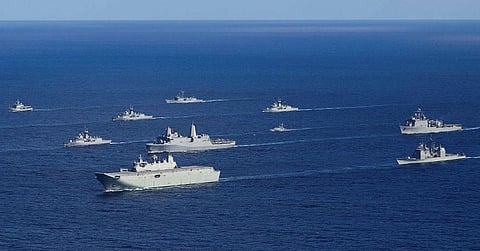

A week before New Zealand declared a National State of Emergency for the devastation caused by Cyclone Gabrielle, Chris Hipkins made the pilgrimage to Canberra expected of freshly minted prime ministers. Those who generalise from single data points might read his press conference with Australian Prime Minister Anthony Albanese as a trans-Tasman concord to tout China's value as an economic partner and skip over any obvious security problems emanating from Beijing's regional activism. But that certainly hadn't been the case in July when Hipkins' predecessor was in Sydney. With China's agreement with Solomon Islands still generating ripples of strategic angst, Jacinda Ardern had joined Albanese in extolling South Pacific regionalism as a counterweight to Beijing's unilateral ambitions.
Yet on China security questions, there are sometimes limits to expressions of Australia-New Zealand unity.
A year earlier in Queenstown, Scott Morrison was asked what his government would expect from New Zealand should Australia end up in a conflict in the Taiwan Strait or South China Sea. The answer, said the leader with too many portfolios, was right there for all to see in the ANZUS Treaty. And on this occasion, there was no obvious comment, let alone endorsement, from the New Zealand side.
That brief moment in the history of the trans-Tasman "family" (to borrow the metaphor favoured by Australian leaders) fed into my musings about what New Zealand might do if Australia actually got into a fight with China. And as my recent article in the Australian Journal of International Affairs indicates, I've concluded that it slightly depends on where that armed conflict occurs.
The best place to start here (analytically, I mean) is a People's Liberation Army (PLA) attack on Australia itself, where the formal and informal drivers of New Zealand's alliance obligation would come together powerfully. Wellington's major defence policy statements customarily commit New Zealand to an immediate response in such an event. Yet there has been an air of cheap talk about these pronouncements given the presumed improbability of the scenario.
That changed when Australian planners undid their long-standing warning time assumptions, a change that was noticed by New Zealand officials in their 2021 Defence Assessment and reiterated in Australia's parliament last week by Defence Secretary Greg Moriarty. Some thinking is now needed about what this actually means for New Zealand. For example, what would Wellington do if Australia was being pressured by China via close-to-the-coast coercion and by escalating cyberattacks? Would that meet the threshold of "an armed attack on the metropolitan territory of any of the Parties" in Article V of the ANZUS Treaty?
And what might (and could!) the New Zealand Defence Force be expected to do, especially if serious fighting began?
Alliance expectations aren't just products of formal undertakings. They also grow around informal patterns of security cooperation. In the event of a PLA-Australian Defence Force clash in the South Pacific, the repeated collaboration of the two trans-Tasman allies in South Pacific crises and emergencies would generate strong expectations of New Zealand coming to Australia's assistance. But Australia-New Zealand security cooperation in the South Pacific has not been based around potential combat against a well-armed state actor. Of course, the South Pacific is not an extension of the South China Sea. But as I argue in my article for AJIA:
Australia's operational calculus would … change if (i) PLA presence levels and activities suggested that an ongoing presence in the South Pacific was imminent, changing the regular distribution of military power; (ii) China secured an actual physical location in the South Pacific where PLA assets could be based (on a rotational or more ongoing basis); or (iii) the PLA began to make it more difficult for the armed forces of Australia and its partners (including New Zealand) to conduct normal exercises, operations and visits and interact with their South Pacific partners.
Of course one might argue that all three of these conditions are already realities for the ADF in East Asia, where Canberra is working with its key partners to uphold a preponderance of Western maritime power. For the most part, New Zealand isn't one of them: closer and closer Australian defence integration with the United States (which the trilateral AUKUS pact between Australia, the United Kingdom and the United States only intensifies) and an increasingly active security relationship with Japan are on top of that list. And however important the acquisition of the P-8 Poseidon patrol aircraft and the ANZAC frigate upgrades are for the NZDF's operations over the next few decades, you'd be hard pressed to argue that New Zealand had a laser-like focus on the demands of high-end Indo-Pacific maritime contingencies.
But in 2021, Australian planners would have noticed that New Zealand forces were exercising off Guam with the visiting UK Carrier Strike Group, and participating in an exercise near Okinawa that involved US carrier battle groups and a Japanese destroyer. That put the Kiwis in close working contact with the northern island chain that constitutes the classic ANZUS Zone in Washington's view. And if one of the tense interactions between the ADF and PLA in the South China Sea escalated by inadvertence or design, it is difficult to imagine that planners in Wellington could simply take a holiday from thinking about their Australian alliance.
One of those South China Sea interactions led newly arrived Australian Defence Minister Richard Marles to call out China for intimidating behaviour. That's a reminder that the Albanese government's efforts to patch up relations with Beijing will only go so far, and probably have little effect on the security side of the equation. It is only right that concerns about getting caught up in a war with China will continue to be a subject for close attention in Australia. And the same situation should be activating New Zealand's most serious thinking for generations about what the trans-Tasman alliance means in an era of rising strategic risks.
